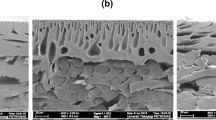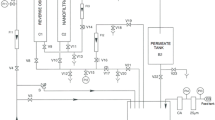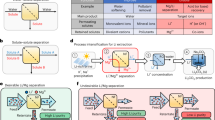Abstract
In this study, nanofiltration with NF200 membrane was employed to remove KCl from ion-exchanged solutions containing potassium clavulanate. The pore radius of NF200 membrane was estimated to be around 0.39 nm. The effects of operating pressure on separation performance were investigated in a range of 100–400 psig. The influences of cross-flow velocity (0.14–0.70 cm/s), temperature (4–25 °C), and feed composition were also investigated. In all experiments, clavulanate rejection showed high levels from 0.91 to 0.99, while chloride rejection ranged from 0.06 to 0.54. In a case at an operating pressure of 50 psig and 25 °C, as much as 94% of clavulanate was retained while 94% of chloride was removed, indicating that NF200 membrane was a suitable choice for selectively removing KCl. NF200 membrane also showed a stable performance in the operational stability test with an ion-exchanged solution obtained by treating actual fermentation broth.











Similar content being viewed by others
Abbreviations
- A J :
-
Frequency factor (L/m2 h)
- A k :
-
Membrane porosity
- C f :
-
Solute concentration in feed (mol/L)
- C m :
-
Solute concentration at membrane surface (mol/L)
- C p :
-
Solute concentration in permeate (mol/L)
- D s :
-
Solute diffusivity (m2/s)
- E J :
-
Permeation activation energy (J/mol)
- H D :
-
Wall correction factor for diffusion
- H F :
-
Wall correction factor for convection
- J s :
-
Solute flux (mol L/m2 h)
- J v :
-
Solution flux (L/m2 h)
- L p :
-
Pure water permeability (L/m2 h psig)
- ΔP :
-
Pressure difference (psig)
- P s :
-
Solute permeability (L/m2 h)
- r p :
-
Membrane pore radius (nm)
- r s :
-
Solute radius (nm)
- R :
-
Gas constant (J/mol K)
- R obs :
-
Observed rejection
- R real :
-
Real rejection
- S D :
-
Steric hindrance factor for diffusion
- S F :
-
Steric hindrance factor for convection
- T :
-
Temperature (K)
- Δx :
-
Membrane thickness (m)
- λ :
-
Ratio of solute radius to membrane pore radius, r s/r p
- Δπ :
-
Osmotic pressure difference (psig)
- σ :
-
Reflection coefficient
References
Brown AG, Butterworth D, Cole M, Hanscomb G, Hood JD, Reading C, Rolinson GN (1976) Naturally occurring β-lactamase inhibitors with antibacterial activity. J Antibiot 29:668–669
Mayer AF, Deckwer WD (1996) Simultaneous production and decomposition of clavulanic acid during Streptomyces clavuligerus cultivation. Appl Microbiol Biotechnol 45:41–46
Butterworth D (1984) Biotechnology of industrial antibiotics. Marcel Dekker Inc., New York
Kim HH, Kang SH, Chang YK (2008) Recovery of potassium clavulanate from fermentation broth by ion-exchange chromatography and desalting electrodialysis. Biotechnol Bioprocess Eng (accepted)
Schäfer AI, Fane AG, Waite TD (1998) Nanofiltration of natural organic matter: Removal, fouling and the influence of multivalent ions. Desalination 118:109–122
Xu Y, Lebrun RE (1999) Investigation of the solute separation by charged nanofiltration membrane: effect of pH, ionic strength and solute type. J Membr Sci 158:93–104
Alborzfar M, Jonsson G, Gron C (1998) Removal of natural organic matter from two types of humic ground waters by nanofiltration. Water Res 32:2983–2994
Kang SH, Chang YK, Chang HN (2004) Recovery of ammonium lactate and removal of hardness from fermentation broth by nanofiltration. Biotechnol Prog 20:764–770
Wu LH (1997) Nanofiltration membrane—a new separating material and its application in pharmaceutical industry. Membr Sci Technol 17:11–15
Sun M, Gan SX, Yin DF, Liu HY, Yang WD (2000) Application of nanofiltration membrane in the purification process of tylosin. Chin J Antibiot 25:172–174
Zhang W, Lin W, Fei ML, Wan HM (1999) Application of the NP composite nanofiltration membrane in the concentration processes of antibiotics. Chin J Antibiot 24:99–101
Zhang W, He GH, Gao P, Chen GH (2003) Development and characterization of composite nanofiltration membranes and their application in concentration of antibiotics. Sep Purif Technol 30:27–35
Kedem O, Katchalsky A (1963) Permeability of composite membranes. Part I. Electric current, column flow and flow of the solute through membranes. Trans Faraday Soc 59:1918–1930
Diwara CK, Lô S, Rumeau M, Pontié M, Sarr O (2003) A phenomenological mass transfer approach in nanofiltration of halide ions for a selective defluorination of brackish drinking water. J Membr Sci 219:103–112
Hafiane A, Lemordant D, Dhahbi M (2000) Removal of hexavalent chromium by nanofiltration. Desalination 130:305–312
Gilron J, Gara N, Kedom O (2001) Experimental analysis of negative salt rejection in nanofiltration membranes. J Membr Sci 185:223–236
Nakao SI, Kimura S (1982) Models of membrane transport phenomena and their applications for ultrafiltration data. J Chem Eng Jpn 15:200
Wang XL, Tsuru T, Togoh M, Nakao S, Kimura S (1995) Evaluation of pore structure and electrical properties of membranes. J Chem Eng Jpn 28:186–192
Cuartas-Uribe B, Vincent-Vela MC, Alvarez-Blanco S, Alcaina-Miranda MI, Soriano-Costa E (2007) Nanofiltration of sweet whey and prediction of lactose retention as a function of permeate flux using the Kedem–Spiegler and Donnan Steric Partitioning models. Sep Purif Technol 56:38–46
Ballet GT, Hafiane A, Dhahbi M (2007) Influence of operating conditions on the retention of phosphate in water by nanofiltration. J Membr Sci 290:164–172
Hilal N, Al-Zoubi H, Darwish NA, Mohammad AW (2005) Characterisation of nanofiltration membranes using atomic force microscopy. Desalination 177:187–199
Bowen WR, Cassey B, Jones J, Oatley DL (2004) Modelling the performance of membrane nanofiltration—application to an industrially relevant separation. J Membr Sci 242:211–220
Cavaco Morão AI, Brites Alves AM, Diná Afonso M (2006) Concentration of clavulanic acid broths: influence of the membrane surface charge density on NF operation. J Membr Sci 281:417–428
Saitúa H, Campderrós M, Cerutti S, Pérez Padilla A (2005) Effect of operating conditions in removal of arsenic from water by nanofiltration membrane. Desalination 172:173–180
Shi D, Kong Y, Yu J, Wang Y, Yang J (2006) Separation performance of polyimide nanofiltration membranes for concentrating spiramycin extract. Desalination 191:309–317
Kesting RE (1971) Synthetic polymeric membranes. McGraw-Hill, New York
Ratanatamskul C, Yamamoto K, Urase T, Ohgaki S (1996) Effect of operating conditions on rejection of anionic pollutants in the water environment by nanofiltration especially in very low pressure range. Water Sci Technol 34:149–156
Haginaka J, Nakagawa T, Uno T (1981) Stability of clavulanic acid in aqueous solutions. Chem Pharm Bull 29:3334–3341
Wang XL, Tsuru T, Nakao S, Kimura S (1997) The electrostatic and steric-hindrance model for the transport of charged solutes through nanofiltration membranes. J Membr Sci 135:19–32
Paugam L, Taha S, Dorange G, Jaouen P, Quéméneur F (2005) Mechanism of nitrate ions transfer in nanofiltration depending on pressure, pH, concentration and medium composition. J Membr Sci 231:37–46
Acknowledgments
This work was supported by the Industrial Source Technology Development Programs (No. 10032001) of the Korean Ministry of Knowledge Economy.
Author information
Authors and Affiliations
Corresponding author
Rights and permissions
About this article
Cite this article
Kim, H.H., Kim, J.H. & Chang, Y.K. Removal of potassium chloride by nanofiltration from ion-exchanged solution containing potassium clavulanate. Bioprocess Biosyst Eng 33, 149–158 (2010). https://doi.org/10.1007/s00449-009-0360-7
Received:
Accepted:
Published:
Issue Date:
DOI: https://doi.org/10.1007/s00449-009-0360-7




